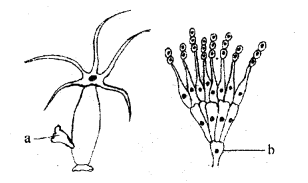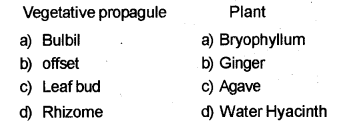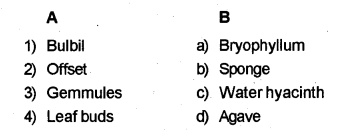Kerala Plus Two Botany Chapter Wise Previous Questions Chapter 1 Reproduction in Organisms
Question 1.
Fill up the blanks after reading the statement: (MARCH-2010)
The postfertilisation events in angiosperms.
Zygote : Embryo
Ovule : ______
Ovary : _______
Answer:
Seed
Fruit
Question 2.
Given below are 3 gametes a, b and c. a and b gametes undergoes fusion. (MARCH-2010)
a) Identify the fusion.

b) Give the explanation for the identification.
Answer:
a) Isogamy
b) Fusion of two morphologically similar gametes (male & female) is called Isogamy
Question 3.
Raman is learning the post-fertilization changes of an angiosperm embryo sac with the help of slides. He identified the egg nucleus and polar nuclei with the help of his teacher. (MARCH-2010)
a) Name the other nuclei present in the embryo sac.
b) Help Raman by giving the changes that takes place with egg nucleus and polar nuclei after fertilization.
Answer:
a) Antipodals and synergids
b) Egg nucleus + Sperm -> Sygote (2n)
Polar nuclei + Sperm -> PEN (3n) primary endosperm nucleus.
Question 4.
Find out which of the statements are true. (MAY-2010)
a) Ovary develops into fruit.
b) In flowering plants, zygote is formed outside the ovule.
c) Ovules develops into fruit.
d) Zygote develops into embryo.
Answer:
Ovary develops into fruit.
Question 5.
Farmers are propagating plants using vegetative structures. Can you mention the names of any two such structures. (MAY-2010)
Answer:
Rhizome – Ginger
Bulb – Onion
Question 6.
Prefertilization events of sexual reproduction in all organisms are gametogenesis and gamete transfer. What are the post fertilization events? (MAY-2011)
Answer:
Formation of zygote
Embryogenesis
Question 7.
You are asked to plant ginger in your home. Which part of ginger you will plant? Name the type of reproduction. (MAY-2011)
Answer:
Underground stem
Asexual reproduction
Question 8.
In asexual reproduction, off springs are produced by a single parent with or without the involvement of gamete formation.(MARCH-2012)
Name the asexual reproductive structures (a & b) given below.
Answer:
a) Bud
b) conidia
Question 9.
Zoospores are common asexual reproductive structures in plants and animals with relatively simple organization. Name two other asexual reproductive structures seen in the group. (MAY-2012)
Answer:
Gemmules in sponges, conidia in penicillium
Question 10.
In honey bees and some lizards,female gamete undergoes development to form new organisms without fertilization. This phenomenon is called ________. (MARCH-2013)
Answer:
Parthenogenesis
Question 11.
Morphologically and genetically similar individuals are called ______ . (MARCH-2013)
Answer:
Clones
Question 12.
Match the following terms with regard to vegetative reproduction in plants. (MAY-2013)

Answer:
a-c
b-d
c-a
d-b
Question 13.
a) Amoeba asexually multiplies by binary fission whereas Sponge by _______ (MAY-2014)
b) Water hyacinth vegetatively multiples by offset agave by ______
Answer:
a) Gemmule
b) Bulbil
Question 14.
Match the Column A with B: (MARCH-2015)

Answer:

Question 15.
a) Yeast asexually multiples by budding whereas Penicillium by. (MAY-2015)
b) Bryophyllum vegetatively multiples by adventitious buds water hyacinth by
Answer:
a) Conidia
b) offset/stem
Question 16.
The chromosome number of onion is 16 (2n). Find the chromosome number in the following cells with reasons. (MAY-2015)
a) Endosperm cell
b) Zygote
Answer:
a) 24
b) 16
Question 17.
When a gamete without any fusion develop into a new organism the phenomenon is called ______. (MARCH-2016)
a) Syngamy
b) External fertilization
c) Parthenogenesis
d) Parthenocarpy
Answer:
c) Parthenogenesis
Question 18.
A unisexual flower having no androecium is called _____. (MARCH-2016)
a) Dithecous
b) Dioecious
c) Monoecious
d) Pistillate
Answer:
d) Pistillate
Question 19.
Select the one which is not helping vegetative propagation. (MAY-2016)
a) Bulb
b) Clone
c) Adventitious
d) Eyes of the potato
Answer:
b) Clone
Question 20.
The plant in which adventitious buds along the mar¬gin of leaves give rise to new plants is (MARCH-2017)
a) Water Hyacinth
b) Agave
c) Bryophyllum
d) Dahlia
Answer:
Bryophyllum
Question 21.
In flowering plants male flower is called ______ flower and female flower is known as _______ flower. (MAY-2017)
Answer:
Staminate
Pistillate
